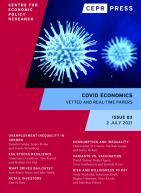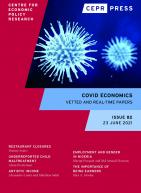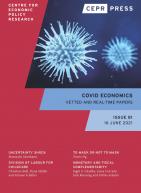
A key question is how countries can gradually exit the covid-19 lockdown in order to re-open their economies and mitigate the huge economic costs that the lockdown is imposing. Answering this question is the first step of the analysis proposed in this paper. Using a benchmark country known to be severely hit by the virus (Belgium), it compares the epidemiological effects of different stereotyped exit strategies. It concludes that, in order to avoid a rebound in infections and follow a relatively quick path toward ending the epidemic, the re-opening of the economy and the society must be very cautious and strict measures of social distancing and an ambitious and effective testing programme must be implemented. The second step, and main point of the paper, consists of exploring the role of a country's culture, more particularly the prevailing contact habits and norms. This is done by substituting the pattern of inter-individual interactions of two other countries for the pattern observed in the benchmark country. The results are striking: differences in the way people interact, and more specifically the frequencies of their contacts within and between age groups, seem to (partly) explain variations in the incidence of the virus and performances in battling against it. More precisely, if Belgium inherited the interaction pattern of Germany when exiting the lockdown, it could achieve the objective of (partial) re-opening of the economy with more moderate policies than the ones it actually needs. And, conversely, if it inherited the social structure of Italy, it would have to take even more stringent measures lest the cost to bear as a result of economic re-opening should be (much) heavier. In addition to differences in the effectiveness of public health policies and in the genetic make-up of population groups, cultural specificities thus appear to play a significant role in explaining international and inter-regional variations in the incidence of the virus and the impact of public interventions.
Citation
Verardi, V and J Platteau (2020), ‘How to Exit Covid-19 Lockdowns: Social Structure Matters‘, COVID Economics 23, CEPR Press, Paris & London. https://cepr.org/publications/covid-economics-issue-23#392514_392899_390478
The COVID19 pandemic has caused shocks to the demand for home childcare (with the closure of schools and nurseries) and the supply of home childcare (with many people not working). We collect real-time data on daily lives to document that UK families with young children have been doing the equivalent of a working week in childcare. Women have been doing the greater share, but overall, the gender childcare gap (the difference between the share of childcare done by women and the share done by men) for the additional, post-COVID19 hours is smaller than that for the allocation of pre-COVID19 childcare. However, the amount of additional childcare provided by men is very sensitive to their employment – the allocation has become more equal in households where men are working from home and where they have been furloughed/ lost their job. There are likely to be long-term implications from these changes – potentially negative for the careers of parents of young children; but also, more positively for some families, for sharing the burden of childcare more equally in the future.
Citation
Smith, S and A Sevilla (2020), ‘Baby steps: The gender division of childcare during the COVID19 pandemic‘, COVID Economics 23, CEPR Press, Paris & London. https://cepr.org/publications/covid-economics-issue-23#392514_392899_391038
We analyse the economics and epidemiology of different scenarios for a phased restart of the UK economy. Our economic model is designed to address the unique features of the COVID-19 pandemic. Social distancing measures affect both supply and demand, and input-output constraints play a key role in restricting economic output. Standard models for production functions are not adequate to model the short-term effects of lockdown. A survey of industry analysts conducted by IHS Markit allows us to evaluate which inputs for each industry are absolutely necessary for production over a two month period. Our model also includes inventory dynamics and feedback between unemployment and consumption. We demonstrate that economic outcomes are very sensitive to the choice of production function, show how supply constraints cause strong network effects, and find some counter-intuitive effects, such as that reopening only a few industries can actually lower aggregate output. Occupation-specific data and contact surveys allow us to estimate how different industries affect the transmission rate of the disease. We investigate six different re-opening scenarios, presenting our best estimates for the increase in R0 and the increase in GDP. Our results suggest that there is a reasonable compromise that yields a relatively small increase in R0 and delivers a substantial boost in economic output. This corresponds to a situation in which all non-consumer facing industries reopen, schools are open only for workers who need childcare, and everyone who can work from home continues to work from home.
Citation
Pichler, A, M Pangallo, J Farmer, F Lafond and R Del Rio-Chanona (2020), ‘Production networks and epidemic spreading: How to restart the UK economy?‘, COVID Economics 23, CEPR Press, Paris & London. https://cepr.org/publications/covid-economics-issue-23#392514_392899_390479
This paper shows that the optimal combination of social distancing and case detection allows for complete and efficient eradication of COVID-19. The first contribution is theoretical. I show that the optimal suppression-policy is a simple function of observable sufficient-statistics, making it easily implementable. I prove that optimal social distancing is the strongest when an outbreak is detected, and then gradually relaxed. Â If case detection is sufficiently efficient, social distancing vanishes wholly and quickly; otherwise, it needs to stay in place until a vaccine arrives. The second contribution is quantitative. I find that, if Italy adopts digital contact tracing, total suppression costs only 0.8% of annual GDP. In sharp contrast, under the current detection efficiency, the total cost of suppression amounts to at least 14% of GDP.
Citation
Pollinger, S (2020), ‘Optimal Case Detection and Social Distancing Policies to Suppress COVID-19‘, COVID Economics 23, CEPR Press, Paris & London. https://cepr.org/publications/covid-economics-issue-23#392514_392899_390480
We survey a representative sample of US households to study how exposur to the Covid-19 stock market crash affects expectations and planned behavior. Wealth shocks are associated with upward adjustments of expectations about retirement age, desired working hours, and household debt, but have only small effects on expected spending. We provide correlational and experimental evidence that beliefs about the duration of the stock market recovery shape households' expectations about their own wealth and their planned investment decisions and labor market activity. Our findings shed light on the implications of household exposure to stock market crashes for expectation formation.
Citation
Wohlfart, J, A Weber, A Weber and T Hanspal (2020), ‘Exposure to the COVID-19 Stock Market Crash and its Effect on Household Expectations‘, COVID Economics 23, CEPR Press, Paris & London. https://cepr.org/publications/covid-economics-issue-23#392514_392899_390481
We develop a multiple-events model and exploit within and between country variation in the timing, type and level of intensity of various public policies to study their dynamic effects on the daily incidence of COVID-19 and on population mobility patterns across 135 countries. We remove concurrent policy bias by taking into account the contemporaneous presence of multiple interventions. The main result of the paper is that cancelling public events and imposing restrictions on private gatherings followed by school closures have quantitatively the most pronounced effects on reducing the daily incidence of COVID-19. They are followed by workplace as well as stay-at-home requirements, whose statistical significance and levels of effect are not as pronounced. Instead, we find no effects for international travel controls, public transport closures and restrictions on movements across cities and regions. We establish that these findings are mediated by their effect on population mobility patterns in a manner consistent with time-use and epidemiological factors.
Citation
Tatsiramos, K, B Verheyden and N Askitas (2020), ‘Lockdown Strategies, Mobility Patterns and COVID-19‘, COVID Economics 23, CEPR Press, Paris & London. https://cepr.org/publications/covid-economics-issue-23#392514_392899_390482
During the COVID-19 epidemic in Japan between March and April 2020, Internet surveys were conducted to construct panel data to investigate changes at the individual level regarding preventive behaviors and mental conditions by surveying the same respondents at different times. Specifically, the difference-in-difference (DID) method was used to explore the impact of the COVID-19 state of emergency declared by the government. Key findings were: (1) the declaration led people to stay home, while also generating anger, fear, and anxiety. (2) The effect of the declaration on the promotion of preventive behaviors was larger than the detrimental effect on mental conditions. (3) Overall, the effect on women was larger than that on men.
Citation
Yamamura, E and Y Tsutsui (2020), ‘Impact of the State of Emergency Declaration for COVID-19 on Preventive Behaviors and Mental Conditions in Japan: Difference in Difference Analysis using Panel Data‘, COVID Economics 23, CEPR Press, Paris & London. https://cepr.org/publications/covid-economics-issue-23#392514_392899_390483
We analyse whether the various types of lockdowns implemented around the world mitigated the surge in infections and reduced mortality related to the covid-19, and whether their effectiveness differed in developing vs. developed countries. Our data cover 184 countries from December 31st 2019 to May 4th 2020, and identifies when lockdowns were adopted, along with confirmed cases and deaths. We find that reducing movements within countries has been effective in developed economies -averting about 650,000 deaths- but not in developing ones, that countries that acted fast fared better, and that closing borders has had no appreciable effect, even after fifty-days.
Citation
Lalive, R, Q Gallea, D Kalanoski and J Bonardi (2020), ‘Fast and local: How did lockdown policies affect the spread and severity of the COVID-19?‘, COVID Economics 23, CEPR Press, Paris & London. https://cepr.org/publications/covid-economics-issue-23#392514_392899_390484


Covid Economics - Issue 82
- Restaurant Closures during the Pandemic: A Descriptive Analysis
- Underreporting Child Maltreatment during the Pandemic: Evidence from Colorado
- Covid-19 impact on Artistic Income
- COVID-19, Employment, and Gender: Evidence from Nigeria
- The Importance of Being Earners: Modelling the Implications of Changes to Welfare Contributions on Macroeconomic Recovery
